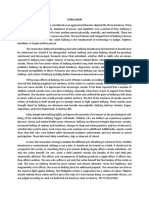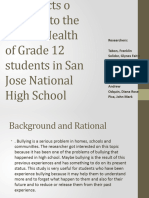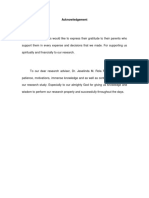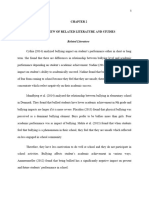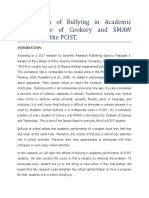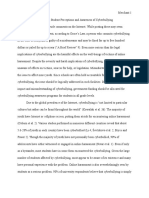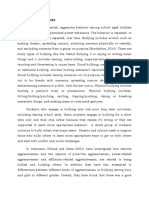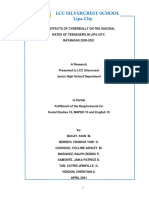High School Bullying
High School Bullying
Uploaded by
toxictouchCopyright:
Available Formats
High School Bullying
High School Bullying
Uploaded by
toxictouchOriginal Description:
Copyright
Available Formats
Share this document
Did you find this document useful?
Is this content inappropriate?
Copyright:
Available Formats
High School Bullying
High School Bullying
Uploaded by
toxictouchCopyright:
Available Formats
Research Paper: Bullying and its Psychological Aftermaths on
Teenagers
April 21,
2010
Introduction
Teenage is a crucial stage - being the transformational period of ones life. During this period
teenagers go through changing physical, psychological and social processes. Among the major
factors contributing towards the development of a teenager, psychological infra- structure plays
an important role. And this very mental development of teenagers is considered to be very
delicate. It can be affected vigorously due to societal, personal or family factors.
A person is being bullied when he/she is exposed, repeatedly and over time, to negative actions
on the part of one or more other persons. Negative action is when a person intentionally inflicts
injury or discomfort upon another person, through physical contact, through words or in other
ways. The actions that fall under bullying are : Saying hurtful and unpleasant things , making
fun of others ,using mean and hurtful nicknames ,completely overlooking someone, deliberately
excluding someone from a group of friends, hitting, kicking, pulling hair, pushing or shutting a
person inside ,telling intentional lies to dominate, spreading false rumors ,sending mean notes
,trying to get other students to dislike another person and many more. (Olweus, 1993, p.42).
Bullying is one of the most common destructive social practices experienced by both children
and adults. There is a growing body of research which indicates that individuals, whether child or
adult who are persistently subjected to abusive behavior are at risk of stress related illness which
can sometimes lead to suicide. Furthermore passive bystanders in any bullying situation also risk
suffering from anxiety that is brought on by the shame and guilt so often felt at not being able to
Page 1
Research Paper: Bullying and its Psychological Aftermaths on
Teenagers
April 21,
2010
intervene or defend a victim. By not challenging bullying behavior valuable opportunities are
lost in shaping society's needs for respect for each person's dignity. To prevent and counter
bullying effectively there needs to be an understanding of bullying that is based on scientific
evidence. (Moore, n.d.)
Sometimes the psychological impact created by negative mental pressure can be lethal to the
development of a sound mental health of the teens. Research shows a large of teenagers cannot
adjust to the changes occurring puberty stage or adapt with the process comfortably. And so,
during this time bracket, teens often become introvert and very suppressive. If any incidence
disrupts the normal balance during this very delicate period of life , then that effect quantifies
itself- creating a deep impact on a teen mind. These kinds of negative impacts in turn highly
affect mental strength and confidence level. More often, one of the most prominent reasons
affecting the psychological balance is found to be Bullying. Bullying, i.e. repeated use of
aggression by one or more people against another person or group, results in multifarious
psychological consequences changing the nodes of their future life.
Page 2
Research Paper: Bullying and its Psychological Aftermaths on
Teenagers
April 21,
2010
Background
According to definition, Bullying is - "exposed, repeated harassment over time, to negative
actions on the part of one or more other persons." Bullying is a common occurrence that most of
the teenagers face, the consequences sometimes affecting in a higher degree. Aftermath of
bullying can be severe. Bullying is the act of intentionally causing harm to others, through verbal
harassment, physical assault, or other aggressive or subtle methods of coercion.
Bullying often describes a form of harassment perpetrated by an abuser who possesses more
physical and/or social power and dominance than the victim. The harassment can be verbal,
physical and/or emotional. Bullying can occur in any setting where human beings interact with
each other. This includes school, home neighborhoods etc. Bullying is deeply rooted with
discrimination and can exist between social groups, social classes and even between countries.
According to the article, Student Reports On Bullying (2001), bullying can be broken into two
categories -Direct bullying, and indirect bullying (also known as social aggression). Direct
bullying involves a great deal of physical aggression such as shoving and poking, throwing
things, slapping, choking, punching and kicking, beating and other forms of social aggression.
Indirect bullying is characterized by threatening the victim into social isolation. This isolation is
achieved through a wide variety of techniques, including spreading gossip, refusing to socialize
with the victim, bullying other people who wish to socialize with the victim, and criticizing
Page 3
Research Paper: Bullying and its Psychological Aftermaths on
Teenagers
April 21,
2010
.Other forms of indirect bullying can be more subtle and more likely to be verbal, such as name
calling, silent treatment, arguing others into submission, manipulation, gossip/ false gossip, lies,
rumors/ false rumors, staring, giggling, laughing at the victim, saying certain words that trigger a
reaction from a past event, and mocking. (p. 15)
Psychological research suggests that passive victims of bullying are anxious and insecure
(Olweus 1999;Wilton, Craig, and Pepler 2000; and Dodge et al. 1990). Passive victims often
react to provocation by crying, withdrawing, or becoming quiet. This signals that they will not
react or retaliate if they are attacked or insulted. Another type of victim, the provocative
victim, is characterized by both anxious and aggressive reaction patterns (Olweus ,1999).
Provocative victims are likely to counter attack and have difficulty relating emotionally, whereas
passive victims often avoid and acquiesce to their attackers (Wilton, Craig, and Pepler 2000). In
fact, some research has shown that socially rejected boys are more likely to follow an act of
aggression with another act of aggression than are boys who did not experience social rejection
(Dodge et al. 1990). Students who are victims of different types of bullying at school more often
experience or engage in a variety of behaviors different from those of students not bullied. These
behaviors include fear of attack; avoidance behaviors such as truancy from school; skipping
classes, or not participating in extra-curricular activities; weapon carrying; involvement in
physical fights; and varied academic performance. Fear is one by-product of threats and
violence, and those students who are bullied at school may be afraid to attend school (Ericson ,
2001)
Common reactions of bullying include loneliness, depression, anxiety, self-esteem ,increased
susceptibility to illness etc. To illustrate, bullying in most cases refers to abusing a person
Page 4
Research Paper: Bullying and its Psychological Aftermaths on
Teenagers
April 21,
2010
verbally in publicly, insulting remarks etc. These in turn triggers reactions of fear or
dominance ,which chases the victim in prolonged future life. Thus the seed of negativity is
planted in a teen mind that spreads it branches furthermore with his age. Sometimes a promising
child turns into a depressive loner, moving away from the positive aspects of life. The primary
step to ensure a childs healthy mental growth is to draw a cease to any and every kind of
bullying. If conscious awareness can be generated among the reference groups of a teenager,
including the teenager himself then the combined effort of all these can help stop teenage
bullying.
Page 5
Research Paper: Bullying and its Psychological Aftermaths on
Teenagers
April 21,
2010
Research Questions
The questions on which the survey is based are aimed to find out the vitality of hypothesis. The
focus is to find out the aftermath of bullying in a teenagers life, particularly the psychological
aftermath, reflecting the types of mental damage that can occur due to bullying, how it affects the
teenager and ways to combat the ill-practice.
The research questions are mainly targeted to the teenagers as they are the subject concerned in
this research paper. The major areas of research on which the research questionnaires are based
are : Knowledge about teenage bullying, effects (psychological) of teenage bullying, intensity of
the after-effects, duration of the impacts and finally the prevention of teenage bullying.
For the investigation purpose of this study, I addressed the following research questions:
1.
2.
3.
4.
5.
6.
7.
Do you know about teenage bullying?
Do you think it affects psychological health of teenagers?
What do you think are the major reasons behind such frequency of bullying?
Do you think bullying leaves severe impact?
What do you think is the most severe psychological impact of bullying?
How long do you think the effect persists?
What according to you is the best way of prevention?
The research questions helped me to design my survey questionnaire and in turn helped me to
analyze my hypothesis with the answers received. The questions were placed and presented in
such a way that it made the respondents think about the subject matter and thus trigger an
intention in them to know about it furthermore.
Page 6
Research Paper: Bullying and its Psychological Aftermaths on
Teenagers
April 21,
2010
Hypothesis
From my personal perspective, I think bullying creates mammoth effects in teenagers mind. I
want to explore the after- effects of bullying (mainly psychological) to identify them at early
stage and take necessary steps to lessen the intensity of probable damage.
I expected that teenagers will be able to clearly identify the negative effects of bullying and
themselves seek counseling to cease their mental sufferings.
I also expected that bullies continue their behavior because they are not aware of the long term
impact of their actions on themselves as well as others.
Finally, I think that most people dislike bullying and are prepared to step forward to stop
bullying.
Page 7
Research Paper: Bullying and its Psychological Aftermaths on
Teenagers
April 21,
2010
Research Methodology
For my primary research I made a questionnaire having 10 questions. I designed the
questionnaire covering all the major areas vital to the objective of my research findings. For each
question only one answer was accepted. Depending on the questions the options varied. Some of
them had six options and some of them had two. The survey was conducted among 40 people in
total. All of them were teenagers as they were the major subject of my research. Most of my
surveyors were students from schools & colleges. Students from Sunbeams, BIT, Sunnydale,
Govt. Lab High School, Notredame College, City College, ESS, Mastermind etc participated in
my survey.
The information I collected from the students and teachers were not enough so I had to visit
some of the websites that dealt with these issues. The websites also helped me with some
important information that I needed to have for a standard questionnaire. For a more detailed
primary research, I took interviews of teachers, pediatrics and teenagers themselves to gain a
focused understanding about their perspective on the subject matter.
For my secondary research, I used North South University library resources, Public library
resources, resources from The British Council. From the web, I used online teen health journals
and magazines, potential web-sites on the subject matter, search engines like Google, reference
based websites like Wikipedia, Scribd etc.
Page 8
Research Paper: Bullying and its Psychological Aftermaths on
Teenagers
April 21,
2010
Data Representation
I have conducted the survey to analyze the effects on bullying on teenage mind. The survey was
conducted on 30 teenagers with questions aimed to bring out the impacts, duration and aftermath
of bullying. The results are interpreted below:
Knowledge about teenage bullying
Explanation and analysis:
Knowledge about teenage bullying is expressed through the pie chart above. The pie-chart
demonstrates that majority (56%) of the respondents didnt know about teenage bullying in-
Page 9
Research Paper: Bullying and its Psychological Aftermaths on
Teenagers
April 21,
2010
depth. On an average, 30% knew about teenage bullying fully. A minority of 14% didnt know
about it at all.
It is noticeable that on average, the teenagers although are very much acquainted with the term
Bullying, most of them are not aware of its factual meaning. They only have a vague idea
about the concept. I think this is one of the major reasons of bullying - absence of ample
knowledge about it. This very ignorance about the subject matter could be a cause leading to the
increasing frequency of bullying.
Relating the result to my hypothesis, the fact can therefore be established that knowledge about
bullying is vital as in most cases ignorance leads to profuse negative action.
Knowledge about eff ects of teenage bullying
Page 10
Research Paper: Bullying and its Psychological Aftermaths on
Teenagers
April 21,
2010
Explanation & analysis:
The bar chart depicts the knowledge about the effect of bullying. In the bar chart above, the
psychological impacts are represented in vertical axis and the percentage conforming to the
options are represented in the horizontal axis. From the bar-chart display it can be said that a
significant portion (70%) of the survey sample thinks bullying may or may not affect
psychological balance. Equal portions of surveyors (18%) agreed that bullying surely affects
psychological health, while (12%) said that bullying doesnt affect psychological health at all.
The striking feature is that most of the teenagers are not even aware that it leaves a psychological
impact. They vaguely think it might or might not. If the bullies dont realize it leaves a major
impact in the first place, then it might be said that they does it out of mere fun and not actively to
cause a negative impact trailing behind.
Page 11
Research Paper: Bullying and its Psychological Aftermaths on
Teenagers
April 21,
2010
Intensity of impact created by Bullying
Explanation & analysis:
In the chart above, the intensity of impact is represented in the horizontal axis and the percentage
of surveyors conforming to the respective options is shows in the vertical axis. The graph
presents the intensity of impact created by bullying. As the graph illustrates, maximum (55%)
respondents believe bullying leaves major psychological impact. 37.5% of them expressed that
bullying leaves a little effect. On the other hand, an insignificant portion of 7.5% stated that
bullying doesnt leave an effect at all. The average notion about the intensity of impacts is that
bullying might affect a little bit.
Analyzing the graph, it can be projected that majority of the respondents unanimously agree on
the fact bullying leaves a psychological impact- no matter of what degree. The intensity or
degree might vary subject to certain conditions or parameters, but its presence cant be disagreed
upon .Hence its certain that the degree might vary, but the existence of the impact of bullying
Page 12
Research Paper: Bullying and its Psychological Aftermaths on
Teenagers
April 21,
2010
cant be denied. Thus, this leads successfully to my hypothesis confirming the existence and
intensity of the effect in a parallel way.
Major psychological impacts created by bullying
Explanation and analysis:
The fragmented pie chart represents the most severe psychological impact of bullying.
Commonly occurring probable psychological impacts are displayed in fragments of the pie chart.
The graph reveals a mixed result. A vital portion (30%) indicates that the major psychological
impact is that it severely affects the psychological health of teenagers. Another important
fraction of the survey believes that bullying makes a teenager helpless. Equal percentage of
Page 13
Research Paper: Bullying and its Psychological Aftermaths on
Teenagers
April 21,
2010
respondents (17.5%) expressed that bullying initiates low esteem and it destroys confidence
level. Considerably minimum portion of the sample surveyors expressed that bullying makes the
teenager introvert and depressed.
Hence from the graphical illustration we can clearly conclude that there are multifarious
psychological effects of bullying. The spans of the effects are quite random and large in number.
Most commonly occurring psychological impacts are listed hereby, there could be a lot more
other effects but they vary to a large extent and so they have not been incorporated with the
options above. However it is for certain from the survey result that bullying leaves negative
psychological effect that in turn affects mental health of teenagers.
Span of effect
Explanation & Analysis:
Page 14
Research Paper: Bullying and its Psychological Aftermaths on
Teenagers
April 21,
2010
The doughnut-chart demonstrates the span of duration of the effects created by Bullying.
Majority (90%) of the respondents expressed that Bullying leaves its effects in present and future
life.A trivial (10%) respondents think Bullying has its effect in future life only.
As I have referred in my hypothesis, Bullying imprints its effects for a considerable amount of
duration to a certain extent. The span of duration is sometimes the present teenage life only,
sometimes its a proportionate mixture of present and future life, and at other times its only
future life. However, most of the times, as survey results depict the effects chase present and
future life.
Main reason for bullying
Explanation & Analysis:
Page 15
Research Paper: Bullying and its Psychological Aftermaths on
Teenagers
April 21,
2010
The bar chart above represents the main reasons for bullying as identified by the target
respondents. 67% of the respondents felt that the main reason for bullying is to have fun. 20%
responded that it made the bullys feel powerful, while 13% said that it is because everyone does
it.
From the above results, we can infer that most teenagers engaged in bullying do it because it for
a good laugh. This means that if bullies are made aware of the consequences of their actions,
maybe they will stop victimizing others. The 20% who said that it made the bully feel powerful
are probably the ones who cannot be changed through awareness and counseling. This is because
this group believes that bullying is an expression of dominance. If they knew the long term
effects of bullying on the victim, they would probably take it as positive reinforcement- the
results of their work.
Page 16
Research Paper: Bullying and its Psychological Aftermaths on
Teenagers
April 21,
2010
Preventing a bully
Explanation and analysis:
The pyramid chart demonstrates and classifies surveyors clustered in groups according to their
intention or effort in preventing a bully. In the horizontal axis, the actions taken in terms of
prevention are represented while the conforming percentage is expressed in the vertical axis. The
graph represents prevention of a bully.
As the chart depicts, crucial portion (75%) of the respondents wanted to stop a bully but didnt.
Whilst a significant potion expressed (12.5%) that they always stopped bully. Another lesser
fraction (10%) indicates that they tried to stop bully. An insignificant number (2.5%) of
surveyors expressed that they never tried to stop a bully.
Page 17
Research Paper: Bullying and its Psychological Aftermaths on
Teenagers
April 21,
2010
From the graph, we therefore can analyze that the intention of prevention was very much
prevalent among the surveyors. For some reason, maybe they could prevent completely but at
least tried to. The reason could be the fear of being bullied in turn. This contradicts my
hypothesis that most people want to stop bullies.
Best way of prevention
Explanation & Analysis:
The cylindrical chart demonstrates the preventive measures that can be taken to stop a bully. The
horizontal axis represents the preventive measures and vertical axis represents the percentage.
Page 18
Research Paper: Bullying and its Psychological Aftermaths on
Teenagers
April 21,
2010
As the graph depicts, a significant potion of the sample population (35%) agreed that the
knowledge about the effects of bullying is the major preventive measure that can cease a bully.
Another important fraction (28%) revealed that moral teaching by parent could be a probable
solution. A non-negligible portion (25%) expressed that academic counseling could be a help.
8% of the respondents concluded that academic code against rules and regulation can help stop a
bully. A trivial potion (5%) indicated that strict punishment could be vital preventive measure.
None of the survey respondents had anything else to say.
A conclusion can be drawn by saying that preventive measures of bullying vary from person to
person. But since the arena of bullying are commonly academic institutions, so academic
counseling or codes against it can therefore help cease bullying in a more effective way.
Page 19
Research Paper: Bullying and its Psychological Aftermaths on
Teenagers
April 21,
2010
Summary of Survey Findings
Findings of the survey reflects that majority of the target population know vaguely about teenage
bullying. Although they are merely acquainted with the term, they do not have complete
comprehensive knowledge regarding the subject matter. The survey result also predicts thats
majority of the people believe that bullying leaves a psychological impact, that tends mostly to
be negative. Therefore it can be said that most of them believes that bullying leaves prominent
effects on psychological health of teenagers. The major reason identified through the survey,
about bullying is the lack of knowledge regarding the negative after effects of bullying. Most
people are not even aware that bullying can actually hamper so much and thus bullying continues
in an increasing rate. From the survey results, I have also identified that the most common
psychological impact that bullying leaves is that it severely hampers social interactions of
teenagers specially victims. Other psychological effects are however also present, however
majority of people tend to believe this is the most commonly occurring effect generated by
bullying. Regarding the prevention issue, based on the survey results, it can clearly be said that a
considerable number of people have at least tried to stop a bully. Most of the time, maybe they
could not take actual proper actions because of the fear of being bullied back in return, but
however at least the intention to stop a bully was very much prevalent. Another major finding of
the survey is regarding the time span of the after-effects. According to the survey, most people
agreed to the fact that bullying however, generates and leaves effects for a considerable long
period of time, it doesnt leave only a temporary after effect. Finally, as per survey results, the
Page 20
Research Paper: Bullying and its Psychological Aftermaths on
Teenagers
April 21,
2010
conclusion can be drawn on the best way of prevention of bullying. The survey results indicate
that most people think that providing knowledge about the adverse effects of bullying is the most
probable solution of prevention.
Page 21
Research Paper: Bullying and its Psychological Aftermaths on
Teenagers
April 21,
2010
Interviews
For the purpose of my research, I interviewed a teenager (Sameer) who has faced bullying since
the age of ten. Now, at fourteen, he still faces the same problems as he faced before, probably
more. One of my main objectives was to determine what other peoples reactions were when and
after he was bullied. The other was to determine his feeling as a bully victim. What I found out
was that one of the reasons that he was picked on was because the bully wanted attention.
Initially when he was bullied, a lot of his classmates laughed at the bullys (whose name I will
not include) jibes. Sameer said that right after he started getting bullied, first his classmates
started to avoid him and then his school friends. He reasoned that if his friends stuck by him,
pretty soon, they would also start getting picked on. His grades dropping steadily since, and
although he attends all our get-togethers, he always seems a bit distant.
My other interview was with Dr. Firooz, who is a very prominent psychiatrist. The interview was
brief but he helped me draw conclusions upon certain matters that did not appear apparent in the
survey. He said that the reason bully victims try to conform to the roles appointed to them by the
bullies is because the victims themselves want belong to a particular group even if it means
giving in to the bully. They think that if they play their roles, then the bullys will leave them
alone or atleast be less abusive. Lastly he said that in time, the bully victims tend to believe that
they are what they are accused of being. This is because the victims, because of their lack of
knowledge and experience, believe what is said to them.
Page 22
Research Paper: Bullying and its Psychological Aftermaths on
Teenagers
April 21,
2010
Recommendation
After conducting the survey, I have identified that the major reason initiating bullying in the first
place is ignorance regarding the subject matter and its probable effects. I think that if proper
knowledge regarding the bullying and its negative aftermath can be successfully delivered to
teenagers and their reference groups, then bullying can be stopped or at least the intensity of the
negative psychological effects can be minimized to a considerable extent.
According to Dr. Firooz, a psychiatrist by profession, teenage health is controlled by the
sustenance of balanced mental structure. He recommends that any kind of mental trauma of
teenagers should be addressed by parents or teachers or by medical specialists if needed and be
given proper counseling. Counseling is known to have positive outcome and aids active recovery
from mental stress.(Firooz, A.H.M. April 5,2010, personal communication)
Personally speaking, I would recommend that teenagers themselves should be given ample
knowledge regarding the subject matters so that they themselves refrain from it. Academic codes
or student counseling can actually ensure that students refrain from this action. Also, the bullies
should be discouraged by everyone, they should be cornered and in some cases strict
punishments should also be taken to ensure they dont repeat the action. Finally, I think active
support of academic institution, peers, friends, family combined can fight bullying and its
negative effects in an efficient way.
Page 23
Research Paper: Bullying and its Psychological Aftermaths on
Teenagers
April 21,
2010
Conclusion
The research topic was aimed to explore if bullying actually left any psychological impact, and
even if it did then to what extent. The survey results clearly states that my hypothesis was
correct. Bullying does leave major negative effects that can case back even for a prolonged
period of time in future life. Also during the course of time of carrying out the survey, many
respondents thought about bullying twice and the question did trigger a conscience. I chose this
research topic because being a bully victim myself, I am well aware of its negative impacts. And
thus through doing this paper, I performed a complete research on the subject matter and the
results do indicate I was right in my assumption.
Bullying is such an activity which may not be rooted out completely from everywhere. There is
no denial of the fact that it leaves mammoth negative psychological effects affecting present and
future life of teenagers. Teenage is indeed a crucial stage of ones life, the base of personality,
ethics, beliefs, future goals are all formed during the stage. And so, it is everyones duty to
ensure that teenagers can live an active teenage life without negative interruptions like bullying
that upsets their life. Therefore, we all should at least try to lessen the impacts of bullying and the
action of bullying itself, to help teenagers live an enjoyable, robust teen life at full throttle.
Page 24
You might also like
- Cyberbullying Annotated Bibliography FinalDocument8 pagesCyberbullying Annotated Bibliography Finalapi-258925897100% (3)
- Reinventing HotelsDocument2 pagesReinventing HotelsLaveena100% (1)
- Eradicating Cyber Bullying: Through Online Training, Reporting & Tracking SystemFrom EverandEradicating Cyber Bullying: Through Online Training, Reporting & Tracking SystemRating: 5 out of 5 stars5/5 (1)
- ConclusionDocument1 pageConclusionMadelNo ratings yet
- Affecting The Ethical Aspect of A Student Caused by Bullying by Group 2Document4 pagesAffecting The Ethical Aspect of A Student Caused by Bullying by Group 2Abigail GoloNo ratings yet
- Chapter 2 (Complete)Document23 pagesChapter 2 (Complete)Khenji FajardaNo ratings yet
- Research Final g11Document45 pagesResearch Final g11Adrian CasajeNo ratings yet
- The United Methodist Church Ecumenical Christian College Junior High School Department S.Y 2019-2020Document8 pagesThe United Methodist Church Ecumenical Christian College Junior High School Department S.Y 2019-2020Ethiopia TrinityNo ratings yet
- BullyingDocument8 pagesBullyingdiether jay martinNo ratings yet
- Effects of Verbal and Physical Bullying Among The Students of Grade 7 4Document16 pagesEffects of Verbal and Physical Bullying Among The Students of Grade 7 4Chezka Romeo OrolazaNo ratings yet
- The Effects o Bullying To The Mental HealthDocument17 pagesThe Effects o Bullying To The Mental HealthShena Mae SamarroNo ratings yet
- ResearchDocument14 pagesResearchIan Dikit NicolasNo ratings yet
- Negative Effects of Cyber Bullying To StudentDocument2 pagesNegative Effects of Cyber Bullying To StudentJamesan Pasanting Beloy100% (1)
- Final PR1Document32 pagesFinal PR1Dearly Wurtzbach0% (1)
- Bullying Reasearch PaperDocument28 pagesBullying Reasearch PaperRebecca Marcelino100% (1)
- Chapter 2Document9 pagesChapter 2Sugie BarreraNo ratings yet
- CyberbullyingDocument8 pagesCyberbullyingQUINTILLA ALEXXA YNA MARINo ratings yet
- Chapter II VinceDocument8 pagesChapter II VinceDianne RuizNo ratings yet
- Soal SelidikDocument4 pagesSoal Selidikhafazsy100% (1)
- BULLYINGDocument38 pagesBULLYINGRM ValenciaNo ratings yet
- Practical ResearchDocument5 pagesPractical ResearchKeanne HepigaNo ratings yet
- Research Paper (Bullying)Document7 pagesResearch Paper (Bullying)VanissaNo ratings yet
- BULLYINGDocument23 pagesBULLYINGEzraManzano57% (7)
- West Visayas State University: Extension Campus in Himamaylan City Himamaylan City, Negros OccidentalDocument33 pagesWest Visayas State University: Extension Campus in Himamaylan City Himamaylan City, Negros OccidentalMARLON TABACULDENo ratings yet
- BULLYING FinalDocument50 pagesBULLYING Finalagerestrictions0001100% (1)
- The Effects of Bullying in Academic Performance of Cookery and SMAW Students in The PCISTDocument2 pagesThe Effects of Bullying in Academic Performance of Cookery and SMAW Students in The PCISTjohaira caparida100% (1)
- Synthesis PaperDocument10 pagesSynthesis Paperapi-359257144No ratings yet
- Chapter 2Document4 pagesChapter 2Ela Araojo Guevarra100% (1)
- A Qualitative Investigation of Bullying The Perspectives of Fifth, Sixth and Seventh Graders in A USA Parochial SchoolDocument16 pagesA Qualitative Investigation of Bullying The Perspectives of Fifth, Sixth and Seventh Graders in A USA Parochial SchoolFernandoLacerdaNo ratings yet
- Bullying ResearchDocument14 pagesBullying Researchlendiibanez100% (1)
- Chapter 1-3 (REVISED)Document39 pagesChapter 1-3 (REVISED)Jen LabaoNo ratings yet
- Chapter 1 RA 10627Document15 pagesChapter 1 RA 10627Bej Maria100% (1)
- The Effects of Verbal Bullying in The Grade 11 Students at Guisad Valley National National High SchoolDocument20 pagesThe Effects of Verbal Bullying in The Grade 11 Students at Guisad Valley National National High Schoolbealyn menesesNo ratings yet
- Problem and Solution On BullyingDocument3 pagesProblem and Solution On BullyingSean NgNo ratings yet
- Prevalence of Bullying in Grade 10 Junior High School Chapter 1Document16 pagesPrevalence of Bullying in Grade 10 Junior High School Chapter 1HELEN TAANGNo ratings yet
- Research About Cyberbullying Research About CyberbullyingDocument32 pagesResearch About Cyberbullying Research About Cyberbullyingalyza de joseNo ratings yet
- Bullying Experiences of Selected Grade 12 Students at Catanduanes National High SchoolDocument44 pagesBullying Experiences of Selected Grade 12 Students at Catanduanes National High SchoolNathan TabuzoNo ratings yet
- The Impact of Bullying in Adolescents atDocument24 pagesThe Impact of Bullying in Adolescents atEj BobisNo ratings yet
- BullyingDocument18 pagesBullyingLady Love Tariao100% (1)
- Bullying: The Impact of Bullying in The Growth of The Students in Yllana Bay View College Grade 11 Students of Morning ClassDocument4 pagesBullying: The Impact of Bullying in The Growth of The Students in Yllana Bay View College Grade 11 Students of Morning ClassCristine Joyce Campos ParojinogNo ratings yet
- A. Problem and It's BackgroundDocument5 pagesA. Problem and It's Backgroundarisu100% (1)
- BullyingDocument11 pagesBullyingIrah Olorvida100% (3)
- Bullying: Investigating The Effects To The Mental Health of Shs in A Private Autonomous UniversityDocument9 pagesBullying: Investigating The Effects To The Mental Health of Shs in A Private Autonomous UniversityMeryl Parayaoan AlcantraNo ratings yet
- The Impact of Cyberbullying To The Mental Health of The Grade 12 AbmDocument19 pagesThe Impact of Cyberbullying To The Mental Health of The Grade 12 AbmSerene Riego100% (1)
- Influence of BullyingDocument23 pagesInfluence of BullyingDanica FranciscoNo ratings yet
- PR2 LabyuDocument13 pagesPR2 LabyuTres LasafinNo ratings yet
- Philippine Christian UniversityDocument50 pagesPhilippine Christian UniversityChristian Martinez100% (2)
- BullyingDocument24 pagesBullyingMay Ann OmoyonNo ratings yet
- Chapter 3Document3 pagesChapter 3Jericho PauloNo ratings yet
- Group 7 Prelim Chap 3 1Document59 pagesGroup 7 Prelim Chap 3 1Laz FaxNo ratings yet
- Cyberbullying and Self-EsteemDocument9 pagesCyberbullying and Self-EsteemDantrsNo ratings yet
- The Impact of Bullying On The Adolescence Stage of A Student in Saint Mary Magdalene COLLEGES OF LAGUNA S.Y. 2019-2020Document22 pagesThe Impact of Bullying On The Adolescence Stage of A Student in Saint Mary Magdalene COLLEGES OF LAGUNA S.Y. 2019-2020Kyla BañezNo ratings yet
- The Effects of Verbal Bullying To The Selected Senior High School Students in The Valley High Academy in The Year of 2019-2020Document9 pagesThe Effects of Verbal Bullying To The Selected Senior High School Students in The Valley High Academy in The Year of 2019-2020Cristine Rose100% (1)
- BUllYING RESEARCHDocument49 pagesBUllYING RESEARCHGinno Marcelo100% (2)
- Bullying THESISDocument19 pagesBullying THESISlenard CasimNo ratings yet
- Compliance of Students On TheDocument23 pagesCompliance of Students On TheKurt Del RosarioNo ratings yet
- The Effect of Bullying To The Academic Performance of The Learner - FinalDocument11 pagesThe Effect of Bullying To The Academic Performance of The Learner - Finaldesiree dulawanNo ratings yet
- Sunod Sa ChapterDocument76 pagesSunod Sa ChapterJoseph Baldomar100% (1)
- Timothy ArtikelDocument6 pagesTimothy ArtikelSinatra SinagaNo ratings yet
- Prudential Regulations Report 1.0Document4 pagesPrudential Regulations Report 1.0toxictouchNo ratings yet
- Peda Ting Ting (Menu Details)Document6 pagesPeda Ting Ting (Menu Details)toxictouchNo ratings yet
- Performance of HSBC BankDocument44 pagesPerformance of HSBC BanktoxictouchNo ratings yet
- Prime Bank Project ReportDocument96 pagesPrime Bank Project ReporttoxictouchNo ratings yet
- Mirinda ReportDocument39 pagesMirinda Reporttoxictouch0% (1)
- ACI Limited-Final SlidesDocument22 pagesACI Limited-Final SlidestoxictouchNo ratings yet
- Shokti DoiDocument34 pagesShokti Doitoxictouch100% (1)
- Ratio Analysis On Dhaka BankDocument8 pagesRatio Analysis On Dhaka Banktoxictouch100% (1)
- Mirinda ReportDocument39 pagesMirinda Reporttoxictouch0% (1)
- Project On GMG AirlinesDocument29 pagesProject On GMG AirlinestoxictouchNo ratings yet
- Ntroduction: Facts AND FiguresDocument4 pagesNtroduction: Facts AND FigurestoxictouchNo ratings yet
- This Is Peru!: Activity 3: Dos and Don'ts! Lead inDocument4 pagesThis Is Peru!: Activity 3: Dos and Don'ts! Lead inAndres Huaman VilaNo ratings yet
- 7th Grade Geometry Unit PlanDocument5 pages7th Grade Geometry Unit Planapi-254031592No ratings yet
- Alfred Lord Tennyson MCQs (English Literature & Famous Authors)Document11 pagesAlfred Lord Tennyson MCQs (English Literature & Famous Authors)Sushil Bhat100% (1)
- Remedial Law PresDocument30 pagesRemedial Law PresRamil F. De JesusNo ratings yet
- Noli Me TangerepptxDocument17 pagesNoli Me TangerepptxMa. Floresa MendozaNo ratings yet
- Revisi FX Rekapan Kegiatan Pengurus Minggu 3 Oktober 24Document2 pagesRevisi FX Rekapan Kegiatan Pengurus Minggu 3 Oktober 24Rzal HaqNo ratings yet
- Service TrainingDocument76 pagesService Trainingpunsaurav0% (3)
- Assesing Speaking and PronunciationDocument2 pagesAssesing Speaking and PronunciationChristian P. HernandezNo ratings yet
- MPU Type of PronounsDocument10 pagesMPU Type of PronounsK Jia HuiNo ratings yet
- Rule 9 Effect of Failure To PleadDocument3 pagesRule 9 Effect of Failure To PleadLawrence Villamar100% (1)
- An Nahdah (Islamic Revival)Document224 pagesAn Nahdah (Islamic Revival)Abdullah Bin AhmadNo ratings yet
- The Minister of MusicDocument2 pagesThe Minister of MusicARNOLD SAKALANINo ratings yet
- English (4.3) Degrees of Comparison of AdjectivesDocument7 pagesEnglish (4.3) Degrees of Comparison of AdjectivesGenevieve MelgazoNo ratings yet
- Mind Map 9Document1 pageMind Map 9Ayu SuwarniNo ratings yet
- Japanese Film SyllabusDocument7 pagesJapanese Film SyllabusSusan GravesNo ratings yet
- GRADE 4 ENGLISH SUMMATIVE 2 - 2nd QuarterDocument3 pagesGRADE 4 ENGLISH SUMMATIVE 2 - 2nd QuarterGlory MiondaNo ratings yet
- RPP KD 3.1 Xii Lintas Minat - Second Meeting So That PDFDocument1 pageRPP KD 3.1 Xii Lintas Minat - Second Meeting So That PDFKhairul Umam HambaliNo ratings yet
- A Study On Employee Welfare Measures in BhelDocument10 pagesA Study On Employee Welfare Measures in BhelSalman RazaNo ratings yet
- Makovecz AlbumDocument43 pagesMakovecz AlbumZsuzsanna Vári50% (2)
- Learning-Centered Teaching-Concept Map: Balance of Power Function of ContentDocument1 pageLearning-Centered Teaching-Concept Map: Balance of Power Function of ContentJazmine GonzalesNo ratings yet
- 2003-Academic Emergency MedicineDocument154 pages2003-Academic Emergency MedicinealiceNo ratings yet
- 27 - Nadya Rahmasari - Mindmap Chapter 11 PDFDocument1 page27 - Nadya Rahmasari - Mindmap Chapter 11 PDFNadya RahmaNo ratings yet
- TEC 255 - Introduction To ICT (Specialization 2)Document11 pagesTEC 255 - Introduction To ICT (Specialization 2)Princess Ira SantillanNo ratings yet
- CXC Mathematics Form 4 2010 Term1 Paper2 - ANSWERSDocument4 pagesCXC Mathematics Form 4 2010 Term1 Paper2 - ANSWERSAbdullah ZakariyyaNo ratings yet
- Safe Modeling ProcedureDocument4 pagesSafe Modeling ProcedureNikola BozovicNo ratings yet
- Tutor2U Pure Economic LossDocument3 pagesTutor2U Pure Economic Lossbhr88z974cNo ratings yet
- Limit FlowchartDocument1 pageLimit FlowchartRasya MusthofaNo ratings yet
- Narantsetseg TDBDocument36 pagesNarantsetseg TDBБат-Оргил ЧэлсиNo ratings yet
- University of Delhi Admission Category: Unreserved (Merit Based)Document6 pagesUniversity of Delhi Admission Category: Unreserved (Merit Based)Abhilash ChetiaNo ratings yet



